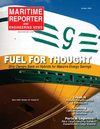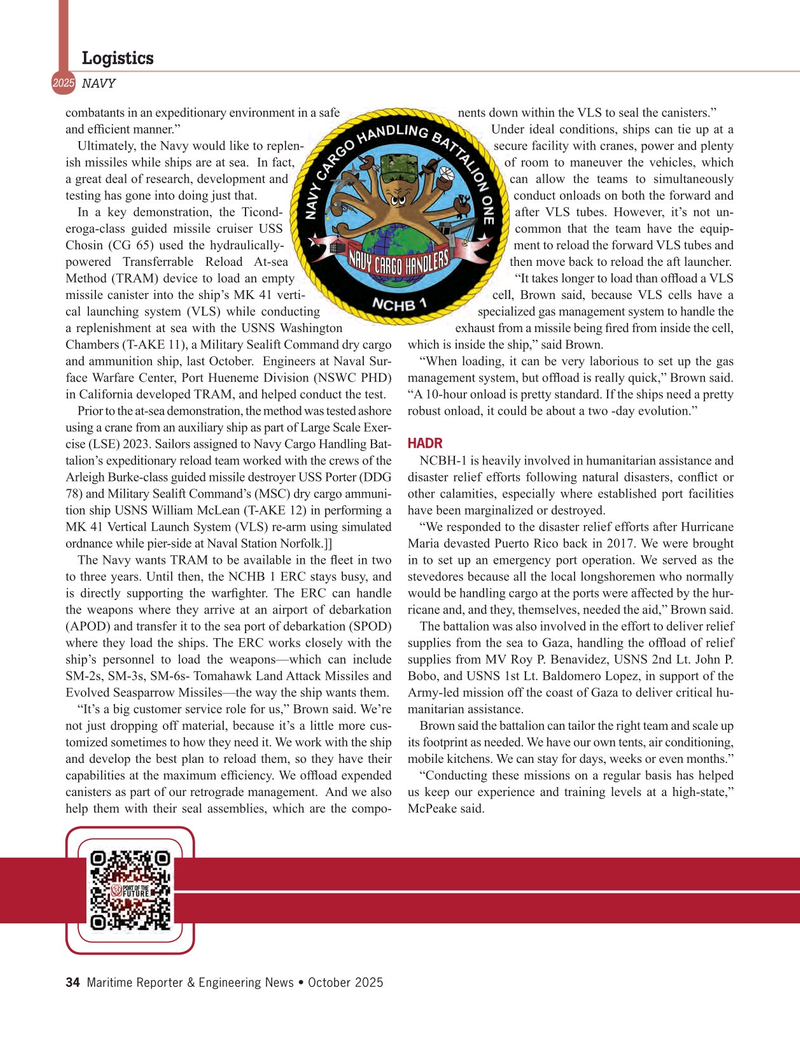
Page 34: of Maritime Reporter Magazine (October 2025)
Read this page in Pdf, Flash or Html5 edition of October 2025 Maritime Reporter Magazine
Logistics 2025
NAVY nents dow nt in a safe combatants in an expeditionary environment in a safe nents down within the VLS to seal the canisters.”
Und and ef? cient manner.” Under ideal conditions, ships can tie up at a sec en- Ultimately, the Navy would like to replen- secure facility with cranes, power and plenty ish missiles while ships are at sea. In fact, t, o of room to maneuver the vehicles, which a great deal of research, development and can allow the teams to simultaneously testing has gone into doing just that. conduct onloads on both the forward and
In a key demonstration, the Ticond- after VLS tubes. However, it’s not un- eroga-class guided missile cruiser USS common that the team have the equip-
Chosin (CG 65) used the hydraulically- ment to reload the forward VLS tubes and powered Transferrable Reload At-sea then move back to reload the aft launcher.
Method (TRAM) device to load an empty y “It takes longer to load than of? oad a VLS cell rti- missile canister into the ship’s MK 41 verti- cell, Brown said, because VLS cells have a specia ucting cal launching system (VLS) while conducting specialized gas management system to handle the htf Whit a replenishment at sea with the USNS Washington exhaust from a missile being ? red from inside the cell,
Chambers (T-AKE 11), a Military Sealift Command dry cargo which is inside the ship,” said Brown.
and ammunition ship, last October. Engineers at Naval Sur- “When loading, it can be very laborious to set up the gas face Warfare Center, Port Hueneme Division (NSWC PHD) management system, but of? oad is really quick,” Brown said. in California developed TRAM, and helped conduct the test. “A 10-hour onload is pretty standard. If the ships need a pretty
Prior to the at-sea demonstration, the method was tested ashore robust onload, it could be about a two -day evolution.” using a crane from an auxiliary ship as part of Large Scale Exer- cise (LSE) 2023. Sailors assigned to Navy Cargo Handling Bat- HADR talion’s expeditionary reload team worked with the crews of the NCBH-1 is heavily involved in humanitarian assistance and
Arleigh Burke-class guided missile destroyer USS Porter (DDG disaster relief efforts following natural disasters, con? ict or 78) and Military Sealift Command’s (MSC) dry cargo ammuni- other calamities, especially where established port facilities tion ship USNS William McLean (T-AKE 12) in performing a have been marginalized or destroyed.
MK 41 Vertical Launch System (VLS) re-arm using simulated “We responded to the disaster relief efforts after Hurricane ordnance while pier-side at Naval Station Norfolk.]] Maria devasted Puerto Rico back in 2017. We were brought
The Navy wants TRAM to be available in the ? eet in two in to set up an emergency port operation. We served as the to three years. Until then, the NCHB 1 ERC stays busy, and stevedores because all the local longshoremen who normally is directly supporting the war? ghter. The ERC can handle would be handling cargo at the ports were affected by the hur- the weapons where they arrive at an airport of debarkation ricane and, and they, themselves, needed the aid,” Brown said. (APOD) and transfer it to the sea port of debarkation (SPOD) The battalion was also involved in the effort to deliver relief where they load the ships. The ERC works closely with the supplies from the sea to Gaza, handling the of? oad of relief ship’s personnel to load the weapons—which can include supplies from MV Roy P. Benavidez, USNS 2nd Lt. John P.
SM-2s, SM-3s, SM-6s- Tomahawk Land Attack Missiles and Bobo, and USNS 1st Lt. Baldomero Lopez, in support of the
Evolved Seasparrow Missiles—the way the ship wants them. Army-led mission off the coast of Gaza to deliver critical hu- “It’s a big customer service role for us,” Brown said. We’re manitarian assistance.
not just dropping off material, because it’s a little more cus- Brown said the battalion can tailor the right team and scale up tomized sometimes to how they need it. We work with the ship its footprint as needed. We have our own tents, air conditioning, and develop the best plan to reload them, so they have their mobile kitchens. We can stay for days, weeks or even months.” capabilities at the maximum ef? ciency. We of? oad expended “Conducting these missions on a regular basis has helped canisters as part of our retrograde management. And we also us keep our experience and training levels at a high-state,” help them with their seal assemblies, which are the compo- McPeake said.
34 Maritime Reporter & Engineering News • October 2025
MR #10 (34-45).indd 34 MR #10 (34-45).indd 34 10/1/2025 7:42:10 PM10/1/2025 7:42:10 PM

 33
33

 35
35
